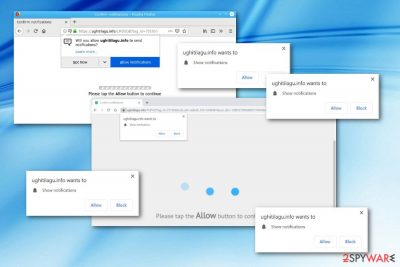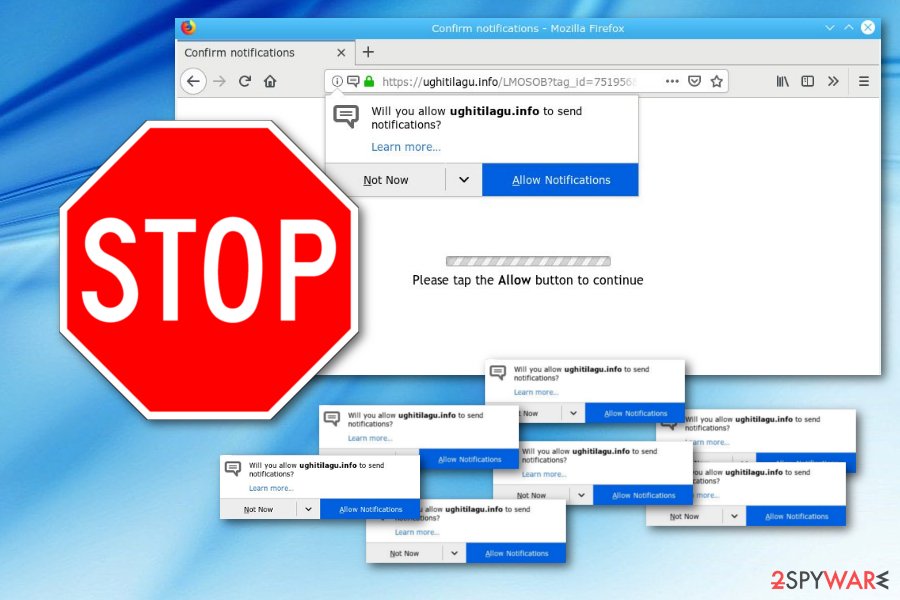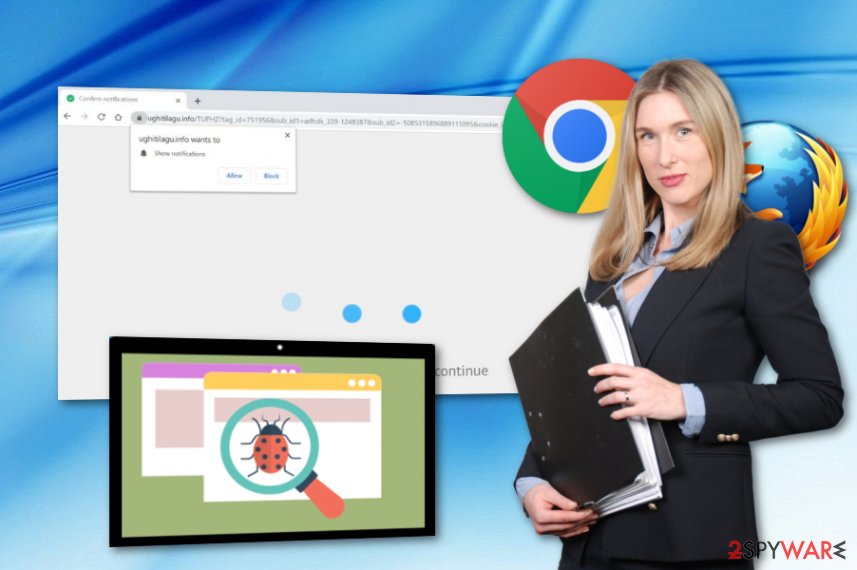Ughitilagu.info (Removal Instructions) - Tutorial
Ughitilagu.info Removal Guide
What is Ughitilagu.info?
Ughitilagu.info – a suspicious URL that might produce dozens of adverts

Ughitilagu.info is a questionable domain that can produce a huge number of ad-based content. This dubious program is one of those ad-supported apps which provide users with the Push Notifications box that tries to convince people to allow the incoming ads to show up on their browser apps. We suggest to BLOCK notifications from Ughitilagu.info virus as the will supposedly mess up with your browsing activities and apply unexpected changes to web browsers that you are likely to use commonly. There are almost only negative sides that are brought by this adware, even the offers that it might push to you might appear to be completely misleading and promoted just to swindle your money.
Ughitilagu.info pop-up comes with two buttons. One is “Allow” and the offer one is “Block”. If you accidentally allow the notifications to load up on your computer screen, take a look at some removal steps for web browsers that have been provided below this article. You will find instructions for Windows, Mac, and Android devices.
| Program name | Ughitilagu.info |
|---|---|
| The type | Adware/ad-supported application |
| Category | Potentially unwanted program |
| Main goal | To get as many subscribers as possible |
| Benefit source | Produced pop-ups and browsing data collected |
| Ad-blocking | Look for instructions near the removal guide at the end of the article |
| Prevention guide | Opt for Custom mode, install antivirus protection to secure your browsing |
| Removal tips | Go for manual or automatical FortectIntego elimination |
Moreover, Ughitilagu.info adware uses sneaky marketing techniques in order to bring benefits for the program developers. Monetary-based revenue is gained by producing a big number of advertisements which is commonly being clicked by different users and visitors. Additionally, income flow also succeeds by sharing browsing-related data with other parties.
One of the most undelightful sides of Ughitilagu.info is that this potentially unwanted program supposedly collects various details that relate to the user's browsing habits, experience, and similar. Most often, such data includes:
- IP.
- Bookmarks.[1]
- Clicked links.
- Pages visited.
- Accounts registered.
- Geolocation.

Preventing this type of non-personal data collection is possible if you remove Ughitilagu.info from the affected operating system and clean all browser applications that are filled with adware-supported content (extensions, plug-ins, add-ons, etc.). You can lengthen the process by downloading and installing antimalware software such as FortectIntego.
Ughitilagu.info removal can also be carried out by using step-by-step instructions that are placed for your guidance at the end of this article. These guidelines will help you to eliminate the cyber threat from infected web browser applications, including Google Chrome, Mozilla Firefox, Safari, Internet Explorer, and Microsoft Edge.
Also, it is very important to get rid of Ughitilagu.info pop-up ads as they might include and intrusive redirecting feature. This means that by clicking on a specific advertisement you might be taken to affiliate websites. Here you take risks of infecting your computer system with malware-laden objects that can be planted in secondary links or similar locations.

Bundled software – the most popular adware hiding place on the Web
If you have been wondering from where did the suspicious adware-related application came from, we have some answers for you. Often, adware gets injected into software packages which is known as bundling. We cannot guarantee 100% that this is how the infiltration happened because adware and other potentially unwanted programs have more than one distribution sources.
However, it is good to know all possible spreading sources for potentially unwanted content as this type of knowledge increases the chances of avoiding infectious threats. Note that, adware can also be hidden in:
- Peer-to-peer sources.[2]
- Secondary downloading links.
- Third-party advertisements.
- Outdated software.
Experts from ZonderVirus.nl[3] claim that taking precautionary measures seriously is one of the best things you can do to ensure the safety of your computer system. Opting for the Custom mode will allow you to take control of all downloads and closing all dubious pages will increase your computer safety. Also, installing antimalware with a secure browsing feature will ensure that you will always be warned when trying to enter a questionable-looking third-party website.[4]
User guidelines for a clearer view of the Ughitilagu.info removal process
Removing potentially unwanted programs should not be difficult if you have done it before or if you have similar experience in the threat removal field. There are two options which will allow you to get rid of the cyber threat from both the operating system and infected web browsers. One of the methods is manual Ughitilagu.info removal.
By getting rid of Ughitilagu.info virus only with your own effort, you need to be ready to face some possible errors during the process and gain knowledge on how to deal with them. However, if you carefully follow our below-given guide, you should not run into any computer problems and be able to clean web browser applications properly.
Also, we have provided some automatical computer cleaning software in case you want to remove Ughitilagu.info by using reputable antimalware. This is actually a very wise and good choice as you decrease the risk of making mistakes during the entire elimination process and missing some crucial infectious components that need to be removed immediately.
Google Chrome (computer/laptop):
- Select your Chrome browser and press the three dots which are in the upper right corner of your window.
- Choose the “Settings” option and continue with the “Advanced” feature.
- Afterward, continue by clicking on “Privacy and Security”, after that, “Content Settings” –> “Notifications”.
- Investigate all URLs and detect suspicious ones.
- Press the three dots near each rogue web page.
- After that, select “Block” or “Remove” for the elimination of the sites.
Google Chrome (Android):
- Select the three dot icon which is placed on the upper right corner of your web browser, and click on “Settings”.
- Continuously, choose the feature that says “Site settings”, and then go for “Notifications”.
- Select each suspicious URL address that you detect.
- Go for the “OFF” feature for “Notifications” that can be found in the “Permissions” directory.
Mozilla Firefox:
- Select the three bar icon on the upper right corner of the browser window.
- After that, click on options “Options” and “Privacy & Security”.
- Scroll until you find “Permissions”.
- Select the “Settings” section that is next to “Notifications”.
- Activate the “Block” function (it can be found in the drop-down menu) for all suspicious links that you see.
Safari:
- Select the Safari browser app and find “Preferences”.
- Then, go for “Websites” –> “Notifications” which are located on the left pane.
- Click “Deny” near to each questionable URL that you discover.
Internet Explorer:
- Search for the gear icon which should be in the upper right corner of the opened browser window.
- Choose “Internet Options”.
- Select on “Privacy Tab”, and then choose “Settings” which can be found under “Pop-up Blocker”.
- Select the “Remove” feature for each suspicious website found.
MS Edge:
- Choose the three dots on the upper right corner of your browser.
- Then, press “Settings”.
- Continuously, go for “View advanced settings”.
- Then opt for “Manage” which is placed beneath the “Website permissions” option.
- Prevent intrusive pop-ups from showing by turning off a switch which is placed near each dubious URL.
You may remove virus damage with a help of FortectIntego. SpyHunter 5Combo Cleaner and Malwarebytes are recommended to detect potentially unwanted programs and viruses with all their files and registry entries that are related to them.
Getting rid of Ughitilagu.info. Follow these steps
Uninstall from Windows
Adware removal on Windows can be completed with the help of these instructions:
Instructions for Windows 10/8 machines:
- Enter Control Panel into Windows search box and hit Enter or click on the search result.
- Under Programs, select Uninstall a program.

- From the list, find the entry of the suspicious program.
- Right-click on the application and select Uninstall.
- If User Account Control shows up, click Yes.
- Wait till uninstallation process is complete and click OK.

If you are Windows 7/XP user, proceed with the following instructions:
- Click on Windows Start > Control Panel located on the right pane (if you are Windows XP user, click on Add/Remove Programs).
- In Control Panel, select Programs > Uninstall a program.

- Pick the unwanted application by clicking on it once.
- At the top, click Uninstall/Change.
- In the confirmation prompt, pick Yes.
- Click OK once the removal process is finished.
Delete from macOS
Remove items from Applications folder:
- From the menu bar, select Go > Applications.
- In the Applications folder, look for all related entries.
- Click on the app and drag it to Trash (or right-click and pick Move to Trash)

To fully remove an unwanted app, you need to access Application Support, LaunchAgents, and LaunchDaemons folders and delete relevant files:
- Select Go > Go to Folder.
- Enter /Library/Application Support and click Go or press Enter.
- In the Application Support folder, look for any dubious entries and then delete them.
- Now enter /Library/LaunchAgents and /Library/LaunchDaemons folders the same way and terminate all the related .plist files.

Remove from Microsoft Edge
Delete unwanted extensions from MS Edge:
- Select Menu (three horizontal dots at the top-right of the browser window) and pick Extensions.
- From the list, pick the extension and click on the Gear icon.
- Click on Uninstall at the bottom.

Clear cookies and other browser data:
- Click on the Menu (three horizontal dots at the top-right of the browser window) and select Privacy & security.
- Under Clear browsing data, pick Choose what to clear.
- Select everything (apart from passwords, although you might want to include Media licenses as well, if applicable) and click on Clear.

Restore new tab and homepage settings:
- Click the menu icon and choose Settings.
- Then find On startup section.
- Click Disable if you found any suspicious domain.
Reset MS Edge if the above steps did not work:
- Press on Ctrl + Shift + Esc to open Task Manager.
- Click on More details arrow at the bottom of the window.
- Select Details tab.
- Now scroll down and locate every entry with Microsoft Edge name in it. Right-click on each of them and select End Task to stop MS Edge from running.

If this solution failed to help you, you need to use an advanced Edge reset method. Note that you need to backup your data before proceeding.
- Find the following folder on your computer: C:\\Users\\%username%\\AppData\\Local\\Packages\\Microsoft.MicrosoftEdge_8wekyb3d8bbwe.
- Press Ctrl + A on your keyboard to select all folders.
- Right-click on them and pick Delete

- Now right-click on the Start button and pick Windows PowerShell (Admin).
- When the new window opens, copy and paste the following command, and then press Enter:
Get-AppXPackage -AllUsers -Name Microsoft.MicrosoftEdge | Foreach {Add-AppxPackage -DisableDevelopmentMode -Register “$($_.InstallLocation)\\AppXManifest.xml” -Verbose

Instructions for Chromium-based Edge
Delete extensions from MS Edge (Chromium):
- Open Edge and click select Settings > Extensions.
- Delete unwanted extensions by clicking Remove.

Clear cache and site data:
- Click on Menu and go to Settings.
- Select Privacy, search and services.
- Under Clear browsing data, pick Choose what to clear.
- Under Time range, pick All time.
- Select Clear now.

Reset Chromium-based MS Edge:
- Click on Menu and select Settings.
- On the left side, pick Reset settings.
- Select Restore settings to their default values.
- Confirm with Reset.

Remove from Mozilla Firefox (FF)
You can get rid of all helper objects from Firefox by completing this guide:
Remove dangerous extensions:
- Open Mozilla Firefox browser and click on the Menu (three horizontal lines at the top-right of the window).
- Select Add-ons.
- In here, select unwanted plugin and click Remove.

Reset the homepage:
- Click three horizontal lines at the top right corner to open the menu.
- Choose Options.
- Under Home options, enter your preferred site that will open every time you newly open the Mozilla Firefox.
Clear cookies and site data:
- Click Menu and pick Settings.
- Go to Privacy & Security section.
- Scroll down to locate Cookies and Site Data.
- Click on Clear Data…
- Select Cookies and Site Data, as well as Cached Web Content and press Clear.

Reset Mozilla Firefox
If clearing the browser as explained above did not help, reset Mozilla Firefox:
- Open Mozilla Firefox browser and click the Menu.
- Go to Help and then choose Troubleshooting Information.

- Under Give Firefox a tune up section, click on Refresh Firefox…
- Once the pop-up shows up, confirm the action by pressing on Refresh Firefox.

Remove from Google Chrome
Take a look at the following steps and perform them to refresh and clean Chrome from all adware-related content and changes:
Delete malicious extensions from Google Chrome:
- Open Google Chrome, click on the Menu (three vertical dots at the top-right corner) and select More tools > Extensions.
- In the newly opened window, you will see all the installed extensions. Uninstall all the suspicious plugins that might be related to the unwanted program by clicking Remove.

Clear cache and web data from Chrome:
- Click on Menu and pick Settings.
- Under Privacy and security, select Clear browsing data.
- Select Browsing history, Cookies and other site data, as well as Cached images and files.
- Click Clear data.

Change your homepage:
- Click menu and choose Settings.
- Look for a suspicious site in the On startup section.
- Click on Open a specific or set of pages and click on three dots to find the Remove option.
Reset Google Chrome:
If the previous methods did not help you, reset Google Chrome to eliminate all the unwanted components:
- Click on Menu and select Settings.
- In the Settings, scroll down and click Advanced.
- Scroll down and locate Reset and clean up section.
- Now click Restore settings to their original defaults.
- Confirm with Reset settings.

Delete from Safari
Remove unwanted extensions from Safari:
- Click Safari > Preferences…
- In the new window, pick Extensions.
- Select the unwanted extension and select Uninstall.

Clear cookies and other website data from Safari:
- Click Safari > Clear History…
- From the drop-down menu under Clear, pick all history.
- Confirm with Clear History.

Reset Safari if the above-mentioned steps did not help you:
- Click Safari > Preferences…
- Go to Advanced tab.
- Tick the Show Develop menu in menu bar.
- From the menu bar, click Develop, and then select Empty Caches.

After uninstalling this potentially unwanted program (PUP) and fixing each of your web browsers, we recommend you to scan your PC system with a reputable anti-spyware. This will help you to get rid of Ughitilagu.info registry traces and will also identify related parasites or possible malware infections on your computer. For that you can use our top-rated malware remover: FortectIntego, SpyHunter 5Combo Cleaner or Malwarebytes.
How to prevent from getting adware
Choose a proper web browser and improve your safety with a VPN tool
Online spying has got momentum in recent years and people are getting more and more interested in how to protect their privacy online. One of the basic means to add a layer of security – choose the most private and secure web browser. Although web browsers can't grant full privacy protection and security, some of them are much better at sandboxing, HTTPS upgrading, active content blocking, tracking blocking, phishing protection, and similar privacy-oriented features. However, if you want true anonymity, we suggest you employ a powerful Private Internet Access VPN – it can encrypt all the traffic that comes and goes out of your computer, preventing tracking completely.
Lost your files? Use data recovery software
While some files located on any computer are replaceable or useless, others can be extremely valuable. Family photos, work documents, school projects – these are types of files that we don't want to lose. Unfortunately, there are many ways how unexpected data loss can occur: power cuts, Blue Screen of Death errors, hardware failures, crypto-malware attack, or even accidental deletion.
To ensure that all the files remain intact, you should prepare regular data backups. You can choose cloud-based or physical copies you could restore from later in case of a disaster. If your backups were lost as well or you never bothered to prepare any, Data Recovery Pro can be your only hope to retrieve your invaluable files.
- ^ Bookmark. Computer hope. Free computer help since 1998.
- ^ Peer-to-peer file sharing. Wikipedia. The free encyclopedia.
- ^ ZonderVirus.nl. ZonderVirus.nl. Computer security and spyware news.
- ^ Sid Kemp. What is the meaning of a "third party website"?. Quora.com. Relevant questions and answers.























